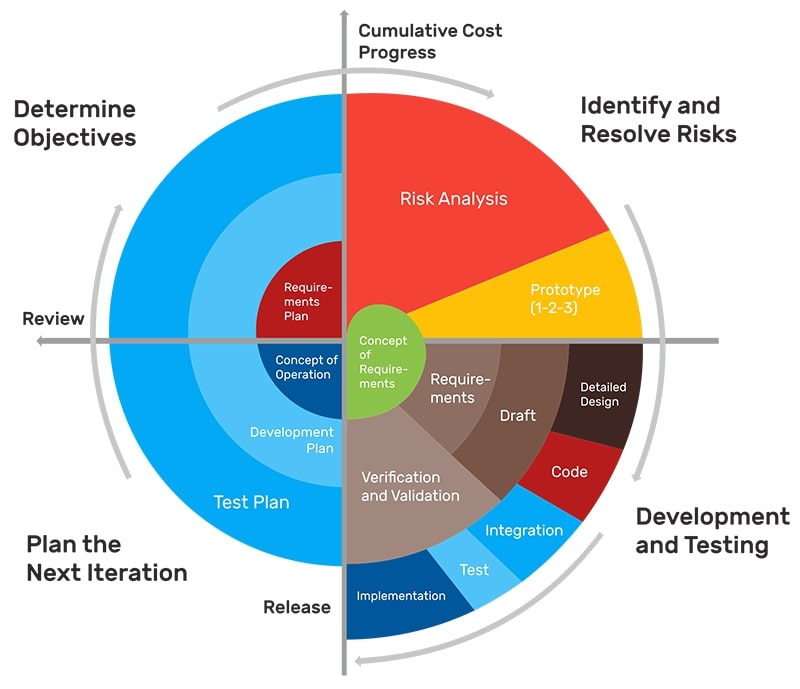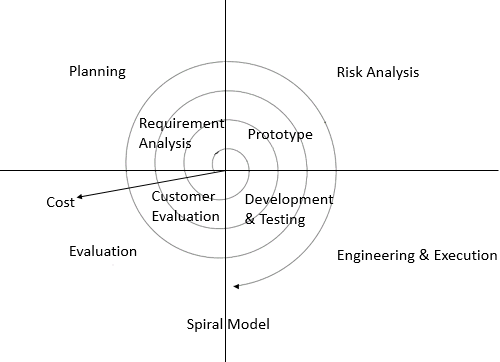Spiral Software Development in SDLC: An Overview
Even with it being less popular compared to other SDLC methods, the spiral model can be an asset in software development when used for the right project. What is it and how can it benefit developers and engineers?
Over the years, software engineers have used the SDLC life cycle to design and produce high-quality software. Some of the most popular SDLC methods include the waterfall, iterative,v-shaped and agile models.
As a less popular model, spiral is seemingly an intimidating framework and high-risk nature, which calls for risk-analysis expertise.
Here’s what the spiral model is and how it can become an asset in the software development life cycle.
What is Spiral SDLC?

The spiral model is a software development process focused on high-risk analysis by combining the iterative process model and elements from the waterfall model.
Each software repeatedly passes through the spiral development process that begins with a team objective and ends with customer feedback. This makes it suitable for large projects with needs for risk evaluation.
What are the phases in the Spiral Model?
Spiral SDLC identifies small system requirements which in turn passes through these four main software development life cycle phases.
The spiral model divides these phases into quadrants wherein feedback along subsequent spirals is used for the development process.
Phase 1: Planning
The first phase begins when the management identifies system requirements for the baseline spiral.
In software engineering, this includes most of the planning processes like cost and resource estimation, goal setting and communicating with the customer for the iteration process.
Phase 2: Risk Analysis
This phase is the most critical step in the spiral model for better risk management.
After planning the necessary requirements, the risk analysis phase focuses on potential risks identification. Risks refer to finding vulnerabilities within the system to improve the overall design of the product.
Evaluation of risks also include necessary software testing for the first prototype. The next step is to apply the necessary changes in the development model. At the end of this phase, a prototype is produced for testing.
Phase 3: Construction/ Engineering
This phase in the spiral model refers to the actual production process of the software. Software design, prototype testing, finalization, and iterations along the spiral are prioritized.
For the subsequent spirals, system requirements are closely monitored to construct a working model of the software.

At the end of each spiral, incremental refinement occurs through iteration.
This model then undergoes software testing and is deployed to the customer for a more detailed customer feedback and software testing.
Phase 4: Evaluation
Evaluation is important specifically for medium to high-risk projects to understand the significant changes to the product before the next iteration begins. Additional functionality, if needed, are added according to the requirements of the customer.
The product prototype then matures through repetitive testing and evaluation until it reaches final product testing.
After the final software testing, the first iteration ends and the cycle repeats until the customer is completely satisfied with the end product after the final iteration.

These four phases show the spiral model as an approach that is focused on flexibility and risk-centred development. These characteristics would truly be more beneficial for large projects than small projects.
Thus, it is important to weigh the pros and cons of using the spiral model if you are planning to use it for your future projects.
We build custom software with modern solutions in mind for any business and sizes!
We build custom software with modern solutions in mind for any business and sizes!
What are the model advantages and disadvantages when you use Spiral model?
With the constant testing needed for each spiral, the expertise needed in risk analysis increases. Moreover, skill requirements to come up with the best product design is also one of the model’s disadvantages.
To understand better, you may want to refer to the table below to weigh the assets and setbacks of the spiral model in terms of management and production in software engineering.
Quick check: Is Spiral model the best choice for you?
To help you assess better, here are three factors you need to consider before using the spiral model in your next project.
- 1. Is your software project large scale?
The spiral model is not suitable for small projects and long term project commitment due to economic priorities. Changes in requirements would require more working time.
Specializations are also important for the spiral model since customer feedback can be highly unpredictable.
- 2. Is the environment of the project high-risk and unstable?
Since tasks move in a spiral motion, the spiral model will work best under a risk induced environment and industries.
Otherwise, the spiral model and its phases are time-consuming and demanding of other workplace requirements.

- 3. Do you have enough funds?
It is best to use the spiral model for projects that have sufficient funding. From engineering skill trainings to the testing and design requirements, it would truly be costly for lesser funded development projects.
What's next?
With the complexities of the spiral model, it is truly crucial to use it only in working environments it was meant for in terms of customer needs and project complexity.
Hence, the advantages and disadvantages are relevant to note especially when economic changes may arise at any time.
If you need further readings to assist you in the development process, you may visit Laneways Software & Digital. We are dedicated to providing software development solutions catered specifically for your needs.
Jerome Rault
Partner with a software development team one that's passionate about creating success
With the broadness of the internet, and it’s continuous expansions across different platforms it is hard to leave a mark that lasts. With digital marketing services, easily make a mark of your own that pulls customers in from different parts of the internet.
